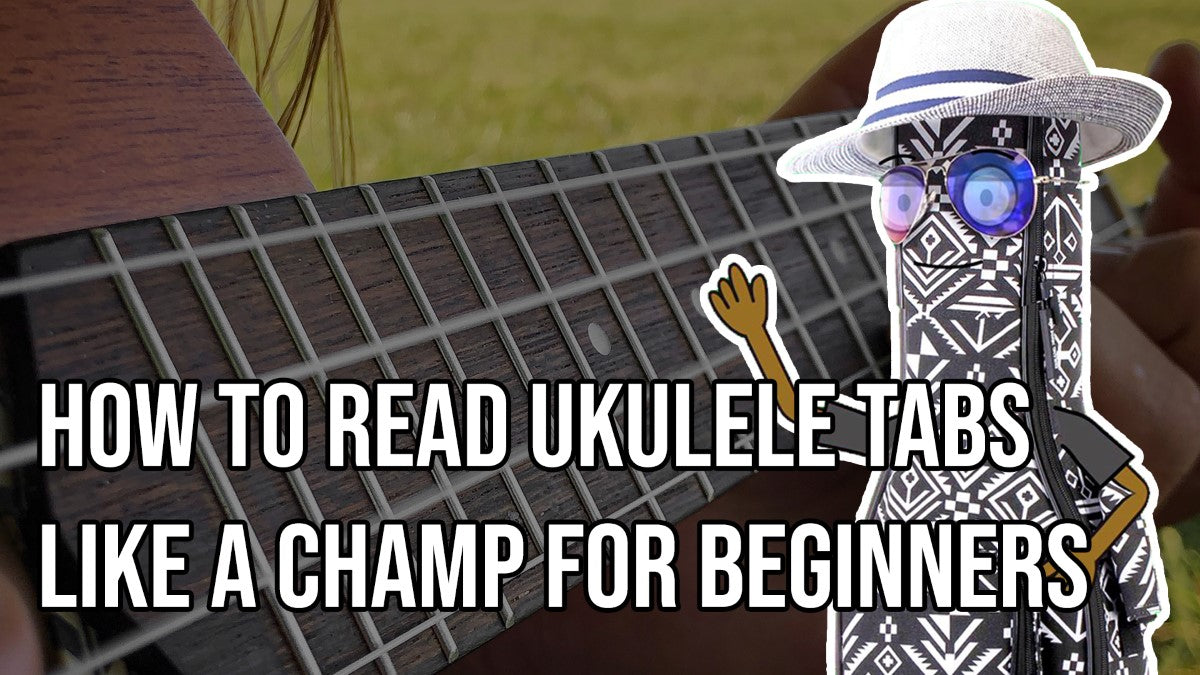How to Read Ukulele Tabs - Like a Champ for Beginners

Hey there, we’re back again for a quick tutorial. This time, we’re going to tackle something that is very important when learning your way through playing the ukulele; How to read ukulele tabs. Sure, some prefer learning songs by ear and that’s a good thing. However, being able to read the tablature means less time actually figuring out what chords or notes you need to hold and play and more time actually practicing them. This is very ideal for beginners, but even advanced and intermediate players can use tabs to easily learn complicated songs. Let’s go!
First thing you need to know is the order of strings. The most normal tuning is Standard C and the order of the string goes like this:
G - C - E - A
The G string is the string closest to the player and the A string is the string closest to the ground when you are playing. In most tabs or guides, you’d be seeing them arranged like this;
A |-----------------------------------------------------------------------------------------------------------------
E |-----------------------------------------------------------------------------------------------------------------
C |-----------------------------------------------------------------------------------------------------------------
G |-----------------------------------------------------------------------------------------------------------------
Fretting
The bar above shows an empty tab. This time, we’ll show you how tabs work. Let’s do one of the easiest chords on the ukulele, the C Major chord. This is done simply by fretting the third fret on the A string and everything else open. This is what it looks like when you read it on a tab.
A |-------3---------------------------------------------------------------------------------------------------------
E |-------0---------------------------------------------------------------------------------------------------------
C |-------0---------------------------------------------------------------------------------------------------------
G |-------0---------------------------------------------------------------------------------------------------------
Simple right? Let’s try another one.
A |-------0---------------------------------------------------------------------------------------------------------
E |-------0---------------------------------------------------------------------------------------------------------
C |-------1---------------------------------------------------------------------------------------------------------
G |-------2---------------------------------------------------------------------------------------------------------
This one is an A Major chord. This indicates that you only have to hold the 2nd fret of G string and 1st fret of C string, then keep the E and A string open.
Hammer Ons
This technique is called hammer-ons because literally, you hit the fret of a string without picking it. The way you look at it in a tab is as follows;
A |-----------------4h5-------------------------------------------------------------------------------------------
E |------------------------4h6------------------------------------------------------------------------------------
C |-----------------------------------------------------------------------------------------------------------------
G |-----------------------------------------------------------------------------------------------------------------
This example shows that you pick the A string while holding the 4th fret then hit the next fret (the 5th one) and then followed by picking the E string while holding the 4th fret, then doing a hammer-on on the same string at the 6th fret. Simple. Right?
Pull-Offs
This one is literally the reverse of hammer-ons. You hold two frets in advance, pick the string and release the higher fret to transition to a lower note as shown below. It indicates that you pick the A string while holding the 5th and 6th fret then releasing the finger holding the 6th fret to transition to the lower note. This is followed by picking the E string while holding the 4th and 3rd fret and releasing your finger on the 4th fret. Catch my drift?
A |-----------------6p5-------------------------------------------------------------------------------------------
E |------------------------4p3------------------------------------------------------------------------------------
C |-----------------------------------------------------------------------------------------------------------------
G |-----------------------------------------------------------------------------------------------------------------
Slides
This one is one of the more advanced techniques on the ukulele. You literally slid from one fret to another within the same string that creates that smooth note transition. How you see that on an ukulele tab is show below;
A |-----------------3/7-------------------------------------------------------------------------------------------
E |------------------------6\3------------------------------------------------------------------------------------
C |-----------------------------------------------------------------------------------------------------------------
G |-----------------------------------------------------------------------------------------------------------------
“/” indicates that you slide up and “\” means you have to slide down. In reality, it’d be easy to tell if you have to slide up or down by looking at the fret numbers. Obviously you won’t be sliding up from fret 4 to fret 1 because you literally go down a couple of notes below. The tab above indicates that you slide up from the 3rd fret of A string to the 7th then slide down from the 6th fret of E string to the 3rd.
Shredding the Ukulele
Getting better eh? There’s still more to it than you think and you’ll be surprised. Now that you’ve spent some time learning the ropes, heck, even reading tabs, at this point you should have already got your own ukulele. Still don’t? Get one now! Broke your current one? Get a replacement that’s absolutely insane, price to performance! Even our Starter Kits’ qualities are beyond the term they go with and guess what, we even have higher end ones that will definitely tickle your fancy because of the great selection of bag design choices that go along with them and the amount of accessories included, you really won’t be able to beat that.
 Lifetime Warranty
Lifetime Warranty  60 Day Return Policy
60 Day Return Policy 1-4 Day Delivery
1-4 Day Delivery






























Leave a comment